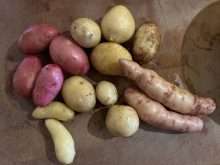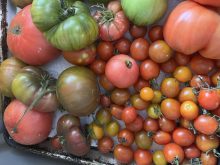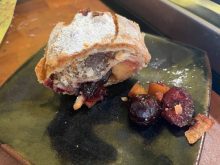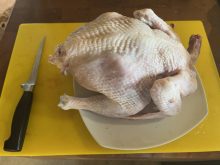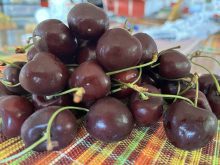When talking about Thai food on the TV show “Parts Unknown,” the late Tony Bourdain said, “It was like discovering a colour I never knew existed before. A whole new crayon box full of colours.” Bourdain loved Thailand, and had the means to visit it repeatedly. Lucky man. But his life was tougher than we could see on our TV screens. I am grateful for his books and TV shows, some of which are on YouTube.
I have not yet been to Thailand. I would love to ride in a tuk tuk — “a golf cart crossbred with a rickshaw,” said Bourdain as he approached the Night Bazaar in an episode set in the city of Chiang Mai, northern Thailand. I want to wander the bazaars, eat street food, revel in the warm air laden with moisture, the smells and scents and sights of the tropics.
Northern Thai cuisine resonates with my palate because its components emphasize hot, sour, sweet, bitter, and salty. Other contrasts include texture — soft/crunchy — and temperature — cold/hot. Bright fruit like mangoes add vibrancy and sweetness.
Here are a few distinctive ingredients for those Thai moments. Look in the Asian produce section of your grocery, or in an Asian market. As a last resort, try online shopping and mail-order shipping, but it’s high risk for anything fragile and fresh.
Coconut milk and coconut cream add their unmistakable notes to sauces, rice, and soups.
Ginger root and its cousin, galangal, add richness, pungency, underlying spiciness, and a suggestion of citrus. Ginger is as aromatic as it is flavourful. Mince or grate it on a medium rasp and leave the threads behind.
Jasmine and sticky rice are both short grained, similar to arborio, which you can substitute in a pinch.
To cook rice noodles, thin or wide, soak in boiling water for about five minutes, then add to the finished dish. Rice noodles disintegrate when reheated.
Thai fish sauce is the same as Vietnamese, made from fermented small fishes and used as a salt condiment added at the end of cooking. It adds irreplaceable umami.
Dried shrimp or shrimp paste add another form of salt underwritten by a hint of the sea.
Some herbs such as cilantro and spearmint (use spearmint, not peppermint), and others may be similar to what you already grow or purchase, such as holy basil or lemon basil. Grow them yourself — they all are generous and easy to grow in season — or buy fresh. Makrut (formerly known as kaffir) lime leaves add an intensely herbal citrus aroma that is irreplaceable. Buy them fresh or frozen, not dried. Look online for several good mail-order sources as a last resort. Triple-bag the leaves and store in the freezer.
Lemon grass, too, is herbal and citrusy. Buy dense stalks and discard the tough external leaves, bottom, and top. Mince, smash, or use bruised larger pieces that can be easily removed in infusions and broths.
Tamarind is sweet and tart, its paste messy to separate from its pits, so I buy a good tamarind chutney at my favourite South Asian store.
First we eat Panang curry, then we talk about how to make other good curry pastes.
Panang Curry
Use turkey, chicken, fish, shrimp, tofu. Serves 6.
Read Also

Gentle treatments for pain in the neck
Heading toward year-end, people unknowingly tense up against the cold and busyness, causing neck pain that can often be treated with appropriate support and gentle mobility, athletic therapist Kathlyn Hossack says.
Curry paste:
- 3 tbsp. soy
- 1 tbsp. chili powder
- 4 tbsp. fish sauce
- 1 tbsp. dried shrimp paste
- 2 tbsp. sweet paprika
- 1 tbsp. ground coriander
- 1 tbsp. ground cumin
- 1 or 2 hot red chilies
- 1/2 tsp. ground cinnamon
- 1/8 tsp. ground nutmeg
- 1/8 tsp. ground cloves
Sauce and protein:
- 1 tbsp. vegetable oil
- 1 small onion, minced
- 6 cloves garlic, minced
- 1/4 c. minced or grated ginger
- 1/4 c. tomato paste
- 4 makrut (kaffir) lime leaves
- 4 boneless chicken thighs or breasts, cubed
- 2 bell peppers, cubed
- 2 tins coconut milk
- 2 tbsp. tamarind paste
- Juice of 1 or 2 limes
- Salt to taste
Garnish:
- Fresh cilantro, holy or lemon basil, or spearmint leaves
- Chopped peanuts
Combine all the paste ingredients and set aside. Heat the oil in a heavy-bottomed pan. Add the onion, garlic and ginger. Sauté, then stir in the tomato paste and curry paste. Mix well and sauté, stirring, for several minutes. Add the lime leaves, chicken, peppers, and coconut milk. Cover and simmer until tender. Season to taste with tamarind paste, lime juice, and salt. Garnish and serve with jasmine or coconut rice.



